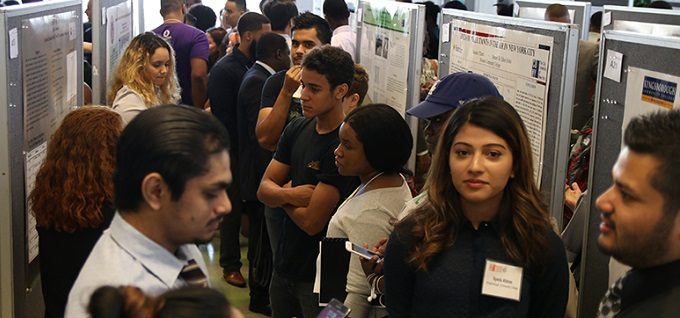Research experiences have major benefits
By Ellie Ashford
June 12, 2019
Undergraduate research is the “gold standard for active learning,” a study reveals.
Community college students who participate in research experiences are more likely to be academically successful, reports a recent study on the City University of New York Research Scholars Program (CRSP).
A quantitative assessment of CRSP — which provides a yearlong faculty-mentored research experience to students seeking associate degrees in community colleges in the CUNY system — found that students who engaged in the program were more likely to stay in a science, technology, engineering and mathematics (STEM) discipline or to graduate with a STEM degree than students in a matched comparison group.
In addition, students in the CRSP group reported an increased sense of belonging in college and said they were more likely to transfer to a research-intensive four-year school within CUNY or a university outside the CUNY system.
“Undergraduate research experiences represent a gold standard for active learning, especially in the sciences,” the report says.
Myriad benefits
Research has cognitive benefits – derived from a learning-by-doing approach, the report continues. It also has non-cognitive benefits, such as increased self-confidence.
“We think this kind of research ultimately has a massive payoff in multiple ways,” says co-author Avrom Caplan, university dean in the CUNY Office of Research. “There’s lots of return on investment.”
Research at community colleges across the country is not the norm, however, due mainly to the lack of institutional capacity and because faculty are often burdened with large teaching loads, according to education advocates. But there are efforts to expand student research at public two-year colleges, through projects such as the Community College Undergraduate Research Initiative. In November, the American Association of Community Colleges will host an invitation-only conference on student research experiences.
“We were fortunate to get $1.725 million from New York City mayor’s office” for CRSP, Caplan says. “We would be happy if every community college got $1 million to do undergraduate research.”
A research culture
Unlike most community college faculty, those at CUNY community colleges are expected to engage in scholarly activities to attain tenure and promotions, the report notes, and that has led to a research culture.
CRSP, launched in 2014, calls for CUNY’s seven community colleges and three comprehensive schools to create a localized program providing 400 hours of STEM research experiences. A faculty mentor is paired with one to three students. Students receive a $5,000 stipend for participating in the yearlong program.
Students in CRSP attend biweekly workshops on laboratory safety, public speaking library research, scientific writing and similar topics. The mentors help them develop and carry out a project, mostly in a lab setting. Having a year to work on a research project gives students plenty of time to get data, make mistakes and fix them, Caplan says.
About one-third of the students in the study were engaged in research in the biological sciences. There were significant numbers of students in environmental sciences, chemistry and social sciences and smaller numbers in engineering, physics, math and computer sciences.
At the end of the year, students present poster sessions at a symposium, and one student from each college gives an oral presentation.
The study included 556 students who participated in CRSP during its first three years. It involved a quantitative longitudinal analysis of student outcomes data, surveys of students’ views and focus groups with faculty mentors.
Compared to the control group, “CRSP students were significantly more likely to graduate in a STEM discipline, especially in general science, biology, chemistry and engineering,” the study found.
At the beginning of the study, approximately 80 percent of CRSP and non-CRSP students had declared STEM disciplines. Seventeen months later, 67 percent of CRSP students and 63 percent of non-CRSP students were still at CUNY. But significantly more were still in a STEM discipline if they had gone through CRSP. As a result, the study reports “participation in CRSP promotes STEM retention and increases the likelihood that students will graduate in a STEM discipline.”
There’s more to the story! Read the full article in CC Daily.


